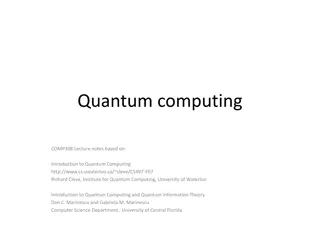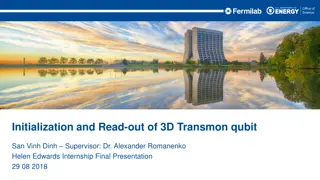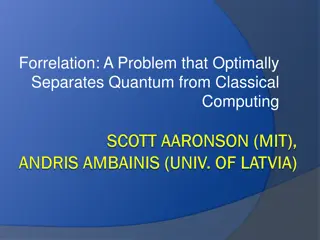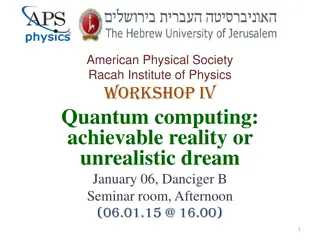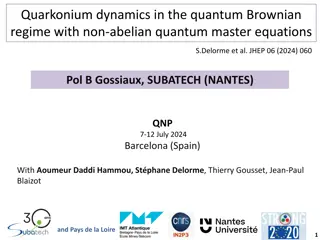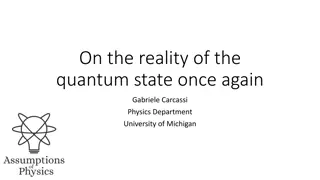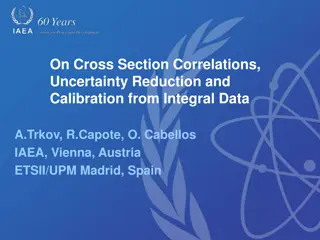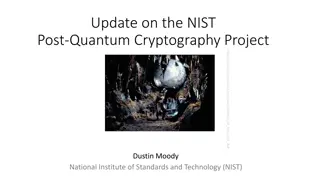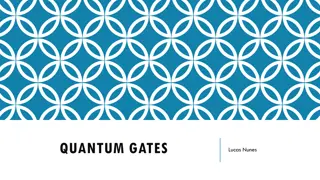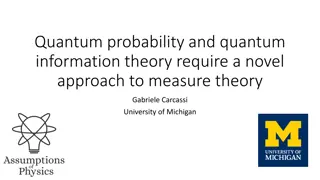Exploring Quantum Information Theory and Correlations
Understand the capabilities of quantum theory compared to other potential theories, such as classical and general box-world scenarios. Dive into concepts like the CHSH game, local classical correlations, PR-boxes, and information causality to enhance your grasp on quantum applications and non-local tasks.
Download Presentation

Please find below an Image/Link to download the presentation.
The content on the website is provided AS IS for your information and personal use only. It may not be sold, licensed, or shared on other websites without obtaining consent from the author. Download presentation by click this link. If you encounter any issues during the download, it is possible that the publisher has removed the file from their server.
E N D
Presentation Transcript
Tony Short University of Cambridge (with Sabri Al-Safi PRA 84, 042323 (2011))
Overview Comparing the information-theoretic capabilities of quantum theory with other possible theories can help us: Understand why nature is quantum Hone our intuitions about quantum applications Surprisingly, despite entanglement, quantum theory is no better than classical for some non-local tasks.... Why? Non-local computation [Linden et al., 2007] Guess your neighbour s input [Almeida et al. 2010] Information causality [Pawlowski et al. 2009]
The CHSH game Random x {0,1} Random y {0,1} Shared resources Alice Bob = a b xy Task : a {0,1} b {0,1} What correlations P(ab|xy) are achievable given certain resources? What is the maximum success probability p in this game?
Local (classical): P(a,b|x,y) = q P (a|x)P (b|y) pC 3/4 (Bell s Theorem - CHSH inequality) Quantum: P(a,b|x,y) = Tr(Pxa Pyb ) pQ (2+ 2)/4 (Tsirelson s bound) General (box-world): a P(a,b|x,y) independent of x Non-signalling conditions b P(a,b|x,y) independent of y pG 1 (PR-boxes)
PR-box correlations [Popescu, Rohrlich (1994)] Optimalnon-signalling correlations (p = 1) = 1 2 a b xy if = ( | ) PPR ab xy 0 a b xy if y x b a b Problem: Is there a good, physical intuition behind pQ (2 + 2) / 4 ?
Information Causality Information causality relates to a particular communication task [Pawlowski et al, Nature 461, 1101 (2009)] Random y {1,...,N} N random bits x1 ... xN m classical bits Bob Alice ( ) (Bob s best Guess of xy) N 1 = by : I x b Task : Maximize y y y
I(x:y) is the classical mutual information ( ) + = H X H Y X I ) ( : x = ( ) ( ) ( ) ( ) log ( ) Y H XY H X p x p x 2 The Information causality principle states ( ) m N = : J I x b y y = 1 y Physical intuition: The total information that Bob can extract about Alice s N bits must be no greater than the m bits Alice sends him. However, note that Bob only guesses 1 bit in each game. The bound on J can easily be saturated: Alice simply sends Bob the first m bits of a.
Information Causality is obeyed in quantum theory and classical theory, and in any theory in which a good measure of mutual information can be defined (see later) Information Causality can be violated by general non-signalling correlations. E.g. One can achieve J=N >> m=1, using = / 1 2 a b x y = ( | ) P ab y x 0 otherwise Information Causality can be violated using any correlations which violate Tsirelson s bound for the CHSH game (when N=2n, m=1) + 2 2 p J m 4
Hence Information Causality Tsirelson s bound Furthermore, it can even generate part of the curved surface of quantum correlations [Allcock, Brunner, Pawlowski, Scarani 2009] But why is this particular task and figure of merit J so important? What about probability of success in the game? Given that J is a strange non-linear function of the probabilities, how does this yield nice bounds on quantum correlations Is mutual information central to quantum theory?
I.C. - A probabilistic perspective If we use probability of success in the Information Causality game, quantum theory can do better than classical Random y {1,...,N} N random bits x1 ... xN m classical bits Bob Alice (Bob s best Guess of xy) ( ) by b = Prob x Task : Maximize y y
When m=1, N=2, maximum success probabilities are the same as for the CHSH game + 3 2 2 = = = C Q G 1 p p p 4 4 The m=1 case for general N has been studied as Random access coding [Ambainis et al 2008, Pawlowski & Zukowski 2010] 1 N 1 1 1 2 = + + C 1 1 p 2 1 N 1 N 2 2 2 N 1 1 + pQ 1 (Known to be tight for N=2k3j ) 2 N
Furthermore, J=y I(xy:by) and the success probability are not monotonically related. E.g. For N=2, m=1 Strategy 1: Alice sends x1 with a bit of noise J= 1- , p=3/4- Strategy 2: Alice sends either x1 or x2 perfectly, based on random bit shared with Bob J 0.38, p= What is the relation between bounds on J and on the success probability, and how do these relate to Tsirelson s bound?
Define pyas the probability of success when Bob is given y, and the corresponding biasEy= 2py 1 When proving Tsirelson s bound, the crucial step uses a quadratic bound on the entropy 2 E ln ( ) ( 1 ( ) ) y y y y = : 1 , J I x b H p p y y y y 2 2 when m=1, Information Causality therefore implies y N 2 2 ln 2 E y = 1 Can we derive a quadratic bias bound like this directly?
Information Causality as a non-local game It is helpful to consider a nonlocal version of the Information Causality game. This is at least as hard as the previous version with m=1 (as Alice can send the message a, and Bob output by=a b ) Random y {1,...,N} N random bits x1 ... xN Bob Alice = a b yx Task : a b
For any quantum strategy 1 + + ) 1 a b x = ( E x y y y N 2 x Using similar techniques to those in the non-local computation paper [Linden et al (2007)] we define 1 1 x x b + x a = = ( ) 1 ( ) 1 x x y y x y N N 2 2 and note that y y = 2 1 E y y y
Hence we obtain the quantum bound N = y 2 y 1 E 1 This is easily saturated classically (a=x1, b=0) With this figure of merit quantum theory is no better than classical. Yet with general correlations the sum can equal N It is stronger than the bound given by Information Causality ( y Ey2 2ln2) Furthermore any set of biases Ey satisfying y Ey2 1 is quantum realizable. This bound therefore characterizes the achievable set of biases more comprehensively than Information Causality.
When we set all Ey equal, then Ey= 1/N, and we achieve 1 1 = + pQ 1 2 N As this non-local game is at least as hard as the original, we can achieve the previously known upper bound on the success probability of the (m=1) Information Causality game for all N. We can easily extend the proof to get quadratic bounds for a more general class of inner product games
Inner product game (with Bobs input having any distribution) N bits y1 ... yN N random bits x1 ... xN y 2 1 E y Alice Bob b = a b x. a Task : y When Bob s bit string is restricted to contain a single 1, this implies the Information Causality result. When N=1, it yields Tsirelson s bound, and the stronger quadratic version [Uffink 2002]
Summary of probabilistic perspective The form of the mutual information does not seem crucial in deriving Tsirelson s bound from Information Causality. Instead, quadratic bias bounds seem to naturally characterise quantum correlations. The inner product game with figure of merit y Ey2 is another task for which quantum theory is no better than classical, but which slightly-stronger correlations help with.
I.C. - An entropic perspective The key role of the mutual information is in deriving Information Causality. The bound J m follows from the existence of a mutual information I(X:Y) for all systems XY, satisfying: 1. Symmetry I(X:Y) = I(Y:X) 2. Consistency I(X:Y)= Classical I when X, Y are classical 3. Data Processing I(X:Y) I(X:T(Y)) for any transformation T I(XY:Z) I(X:Z) = I(Y:XZ) I(X:Y) 4. Chain Rule (Plus the existence of some natural transformations)
But mutual information is a complicated quantity (two arguments), and this list of properties is quite extensive. Instead, we can derive Information Causality from the existence of an entropy H(X), defined for all systems X in the theory, satisfying just 2 conditions: 1. Consistency H(X)= Shannon entropy when X is classical 2. Local Evolution H(XY) H(X)+ H(Y) for any local transformation on X and Y The intuition behind the 2nd condition is that local transformations can destroy but not create correlations, generally leading to more uncertainty than their local effect.
To derive information causality, we can use H to construct a measure of mutual information I(X:Y)=H(X)+H(Y) H(XY), then use the original proof. The desired properties of I(X:Y) follow simply Symmetry trivial Consistency from consistency of H(X) Data Processingequivalent to Local Evolution of H(X) Chain Rule trivial 1. 2. 3. 4. Hence, Information causality holds in any theory which admits a `good measure of entropy. I.e. One which obeys Consistency and Local Evolution. The Shannon and von Neumann entropies are both `good .
We can prove that any `good entropy shares the following standard properties of the Shannon and Von Neumann entropies: Subadditivity H(X,Y) H(X) + H(Y) H(X1X2| Y) H(X1| Y) + H(X2| Y) H(X | Y) 0 whenever X is classical Strong subadditivity Classicalpositivity (where we have defined H(X|Y)= H(XY)-H(Y) ) Instead of proceeding via the mutual information, we can use these relations to derive information causality directly.
This actually allows us to prove a slight generalisation of Information Causality: y ( | ) ( ) H x b H m x y y This generalized form of Information Causality makes no assumptions about the distribution on Alice s inputs x1...xN. The intuition here is that the uncertainty that Bob has about Alice s bits at the end of the game, must be greater than the original uncertainty about her inputs minus the information gained by the message.
Entropy in general probabilistic theories We can define an entropy operationally in any theory [Short, Wehner / Barrett et al. / Kimura et al. (2010) ] Measurement entropy: H(X) is the minimal Shannon entropy of the outputs for a fine-grained measurement on X Decomposition entropy:H(X) is the minimal Shannon entropy of the coefficients when X is written as a mixture of pure states. These both obey consistency, and give the von Neumann entropy for quantum theory. However, for many theories they violate local evolution.
Entropy and Tsirelsons bound (also in Dahlsten et al. 2011) Finally note that due to information causality, Existence of a `good entropy Tsirelson s bound The existence of a `good measure of entropy seems like a very general property, yet remarkably it leads to a very specific piece of quantum structure. This also means that no good measure of entropy exists in physical theories more nonlocal than Tsirelson s bound, (such as box-world, which admits all non-signalling correlations).
Summary and open questions Quantum theory satisfies and saturates a simple quadratic bias bound y Ey2 1 for the Inner Product and Information Causality games, which generalises Tsirelson s bound. Can we find other similar quadratic bounds? The existence of a good measure of entropy in a theory (satisfying just 2 properties) is sufficient to derive information causality and Tsirelson s bound. Is quantum theory the most general case with such an entropy? Is there a connection to thermodynamics?





